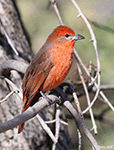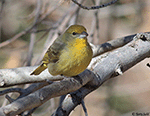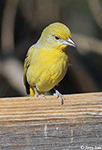Hepatic Tanager
Piranga flava
| Length: 8 inches | Wingspan: 12.5 inches | Seasonality: Non-resident in South Dakota |
| ID Keys: Males red overall, brighter on cap and throat, thick gray bill. Females orange throat and forehead, mostly grayish otherwise | ||
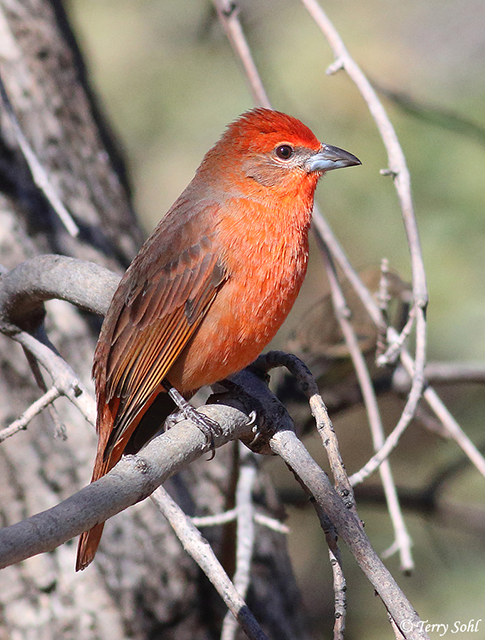 The
Hepatic Tanager is a large tanager of the tropics, with a summer range that
crosses into the U.S. in the southwestern states. They are somewhat
similar in appearance to the Summer
Tanager, but the males are generally duller in color, with a "liver-red"
coloring (hence the name "Hepatic" Tanager). Females are much plainer in
appearance, with a orangish-yellow throat, forehead, and tail contrasting with a
grayish overall plumage on the body.
The
Hepatic Tanager is a large tanager of the tropics, with a summer range that
crosses into the U.S. in the southwestern states. They are somewhat
similar in appearance to the Summer
Tanager, but the males are generally duller in color, with a "liver-red"
coloring (hence the name "Hepatic" Tanager). Females are much plainer in
appearance, with a orangish-yellow throat, forehead, and tail contrasting with a
grayish overall plumage on the body.
Habitat:
In the United States portion of their range, Hepatic Tanagers are found in semi-open pine and pine-oak forests, with a semi-open forest canopy and without a dense forest understory. They can be found in a very wide array of forested habitats in Central and South America.
Diet:
Feeds mostly on insects and spiders, but Hepatic Tanagers will also feed heavily on fruits and berries when available. They will also sometimes feed on nectar.
Behavior:
Forages by deliberately moving through the forest canopy, pausing occasionally as it searches for insects. Insects are gleaned from foliage and branches, and occasionally may be caught in flight. Most of the foraging is done in the tree canopy, but they will also sometimes forage lower in the underbrush of a forest.
Nesting:
The nest is a cup built of grasses and weed stems, placed in a tree, often quite high up in the branches. The female lays between 3 and 5 eggs. Both parents help feed the young after the eggs hatch.
Song:
Slow melodic series of phrases, with clear pauses between phrases. They also have a short t-chek call.
Migration:
Considered a permanent resident throughout most of their range in Mexico. Birds at the northern edge of their range, including those summering in the United States, often move southward for the winter, although a few may linger in the U.S.
Interactive eBird Map:
Click here to access an interactive eBird map of Hepatic Tanager sightings
Similar Species:
There are three other tanager species that could be confused with a Hepatic Tanager, but only two that would be likely to cross paths with one:
- Summer Tanager - Summer Tanagers are the species most likely to be confused with a Hepatic Tanager, as their ranges do intersect in the southwestern US. Believe it or not, male Summer Tanagers are actually more colorful than male Hepatic Tanagers, with a brighter red overall, and a more consistent red coloring. In contrast, male Hepatic Tanagers are a touch duller, and have a grayish red back and cheek patch. Females are similar, in that female Summer Tanagers are brighter (yellow) overall, and female Hepatic Tanagers have a grayish yellow back and cheek patch that's lacking from a Summer Tanager female. Bill colors between the two are also different, with a pinkish bill on a Summer Tanager, and a grayish one on a Hepatic Tanager.
- Western Tanager - Western Tanager males are unlikely to be confused with a Hepatic Tanager, given their unique yellow, red, and black pattern. Female Western Tanagers are quite similar to female Hepatic Tanagers, however. Female Western Tanagers have two obvious wingbars, a feature lacking on Hepatic Tanagers. They also have darker contrasting wings than a female Hepatic Tanager.
- Scarlet Tanager - It shouldn't be an identification challenge most of the time, given the Scarlet Tanager's range in the eastern US, but there have been many scattered sightings of vagrant Scarlet Tanagers in the West. Scarlet Tanager males are more brilliantly red than a male Hepatic Tanager, and have a jet black contrasting wing. Female Scarlet Tanagers are more greenish-yellow and lack the grayish back and cheek of a female Hepatic Tanager. They also have wings that contrast more strongly with the body than does a female Hepatic Tanager.
 |
 |
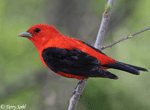 |
 |
| Summer Tanager | Western Tanager | Scarlet Tanager male | Scarlet Tanager female |
Conservation Status:
The Hepatic Tanager has a wide geographic range, throughout much of Mexico, Central American, and South America. Within that range, they are common in many areas, and overall populations are strong. In the United States, systematic surveys indicate modest population increases in recent decades, and the range of the species seems to be creeping northward. The IUCN lists the Hepatic Tanager as a species of "Least Concern".
Further Information:
- Texas Breeding Bird Atlas - Hepatic Tanager
- Audubon Guide - Hepatic Tanager
- WhatBird - Hepatic Tanager
Photo Information:
Photo taken by Francesco Veronesi - Photo licensed under Creative Commons Attribution NonCommercial ShareAlike 2.0 Generic License
Audio File Credits:
- 1Paul Marvin. Recorded in Cochise County, Arizona on July 29th, 2019. Original recording and information available on xeno-canto.
- 2John Van Dort. Recorded in El Salvador on October 29th, 2012. Original recording and information available on xeno-canto.
| Click below for a higher-resolution map |
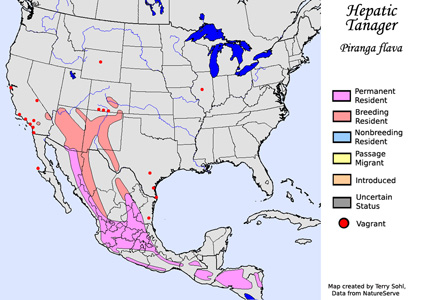 |
| South Dakota Status: Non-resident in South Dakota |
Additional Hepatic Tanager Photos

